
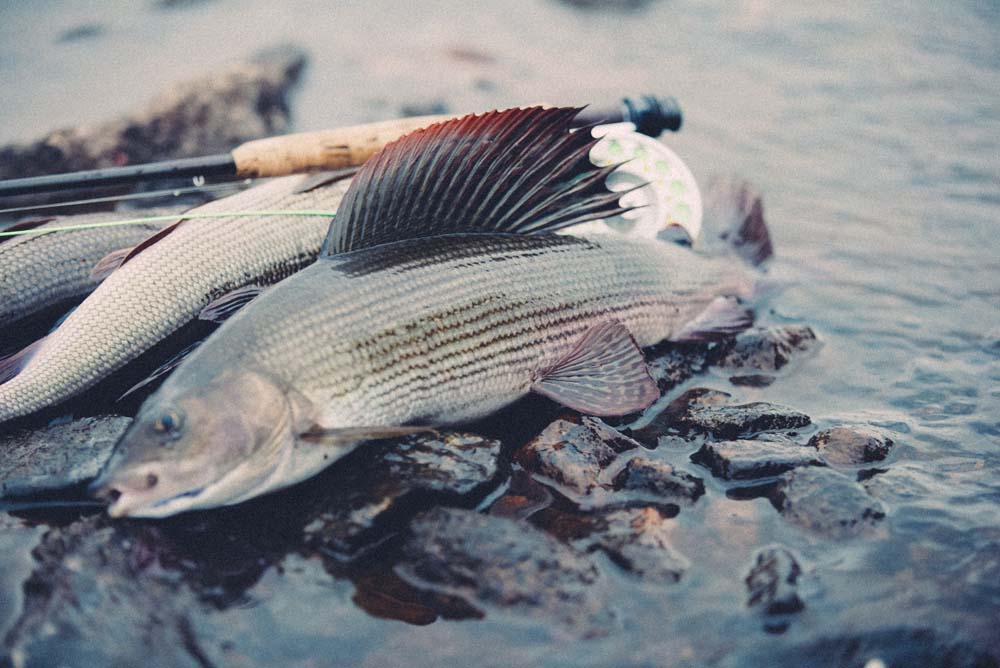
The waters of Lapland host a great population of different species to catch with a broad range of techniques.
Fishing as a lifestyle and profession has been present in the Lapland region for centuries. The local people’s diet generally has been based on what the forests, lakes and rivers have to offer: game, arctic berries and root vegetables, and of course fish.
The people here have been dependant on the catch for their living, but as the profession of a fisherman and life in general have developed, fishing also has turned into a lifestyle and a hobby inviting people from all around the world to experience the local way of life.
We believe, that every angler should keep common sense in their mind and act sustainably in every manner.
Lapland’s clear waters in rivers and lakes might host not just only a multitude of fish species, but the next unforgettable story told to your family and friends.
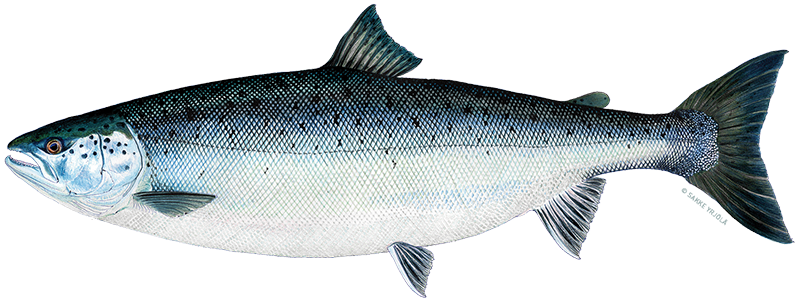
Salmo Salar
Salmon, the king of the river that swims through rough rapids towards the headwaters of the Artery river. The Artery river system is the most productive spawning area of Baltic Salmon, as it is Europe’s largest free flowing river. Salmon starts it journey from the river as a smolt heading to open sea where it reaches maturity. From the sea salmon migrates back to the river for reproducement that happens on the gravels of the headwaters.
Some of salmons spend up to four year at the sea before taking the first trip for spawning. Most commonly the salmon in the Artery river have spent two year at the sea, having the weight between 3-8kg. Some individuals may return up to three times to the river, having the size up to 20kg. Salmon eats only at the sea so the question ”what makes them to bite the lure” still remains a mystery. The Artery river offers anglers a true opportunity to catch these trophy sized salmons. However the salmon should always be fished responsibly.
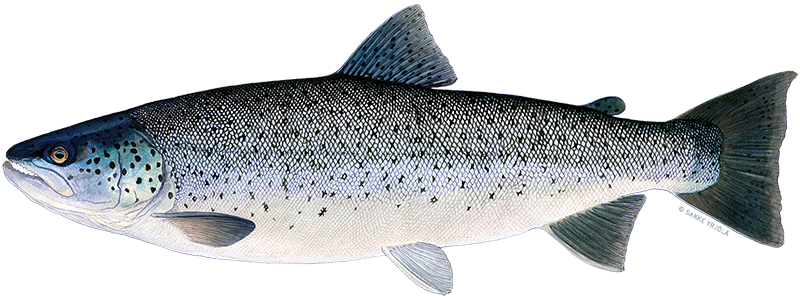
Salmo trutta
Trout is divided into three genres (sea trout, brown trout and lake trout) depending of the living environment and habit of migration. All trouts spawn in flowing water as they have found gravel which has rich oxygen level. Spawning time for trout is during autumn months. Sea trout migrates to the sea to reach maturity returning to the river at spring. Brown trout spawns into the gravels of the stream it may live its whole life. Trout usually prefer cool and clear waters with low nutrition, it’s also more adaptable for changes in conditions than a salmon.
The diet of a trout consists water insects, grubs and shellfish in the rivers and streams, but at the open sea it also eats fish. The growth of a trout depends on its living environment, when in a stream trouts usually don’t grow very large in the sea they may reach a trophy size. As the population of a sea trout in Baltic waters is threatened, fishing for trout should always be performed by sustainable manners. Every trout caught in the Artery river must be released by the law.
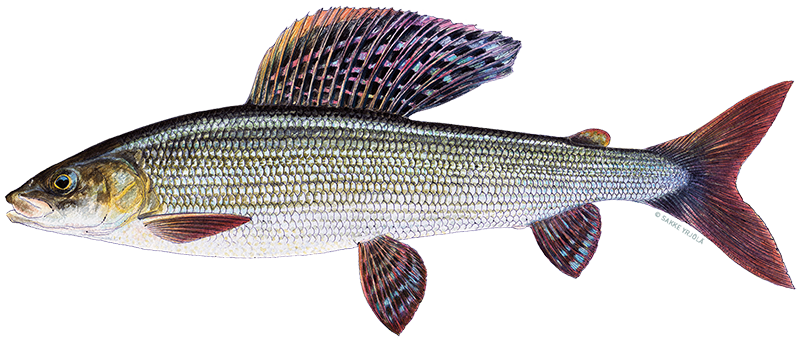
Thymallus thymallus
Grayling has a nickname ”harri” and it’s commonly found in the waters in Northern Finland. Headwaters of the Artery river system are known to be some of the best grayling waters in whole Europe. Grayling is pretty picky with the water quality and it get on well in clear water which Lapland generally has.
Grayling belongs to salmon tribe, but differs from salmon when it comes to migration. It migrates only short distances, especially on spring time trying to find spawning gravel. Spawning happens in flowing and shallow waters. Grayling is great catch for fly fishers as it has wide diet of insects. Therefore it may be fished from bottom, mid-water and from the surface, on both rivers and lakes.
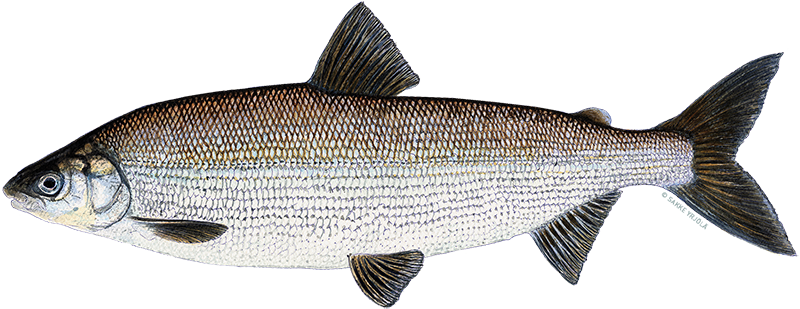
Coregonus lavaretus
Whitefish is a salmonoid mostly known from its family of Coregonus. Whitefish is widely hatched in Finnish waters, but can also be found as wild. Wild reproduction is dependent of proper ground for spawning, such as gravels and sand with high oxygen level. Migration of whitefish may lead all the way down to Baltic Sea, but the fish may as well stay local.
The diet of a whitefish mostly consists plankton and some grubs from bottom. The large ones eat insects and roe, but some may also turn into predators eating fish. Whitefish is spread to most waters in western Lapland and lake Jeris in Muonio region is known to host large whitefish. Fly fishing with dry flies is a challenging method to catch whitefish at the area. Ice fishing is a great way to spend a day with friends with a try of catching whitefish.

Esox lucius
Pike can be found in most fresh waters around the world. Pike is local fish and migrates quite rarely, but may do some kilometers. As an adaptable fish, pike lives in all flowing and still waters in Western Lapland up to Lätäseno and Poroeno rivers. Pike likes to stay in shallow waters where it can find cover in rushes.
Pike grow fairly fast an the females can grow up to 20kg as the males most commonly up to 12kg. Spawning time for pike in the Artery river system is usually in May-June. As a predator pike isn’t very picky for the diet and anything that is easy to catch it will eat. Pike is a perfect target for anglers as it fight well and stands handling quite well to be released. Waters on the Lappish region are know to host some monster pikes that are waiting to be found.
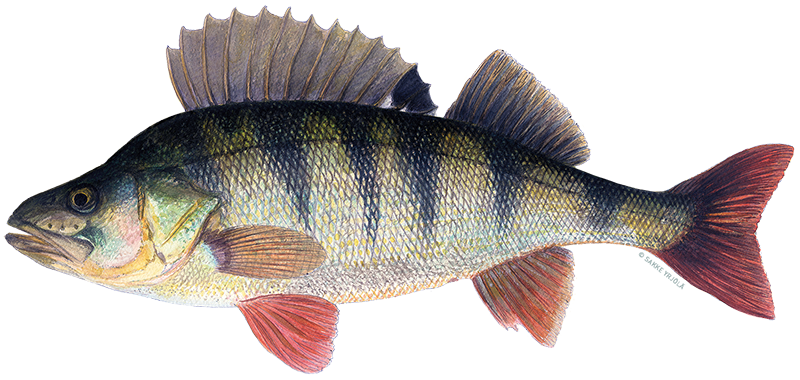
Perca fluviatilis
Perch is the national fish of Finland for a reason as it is the most common of fish species in Finnish waters. As an adaptable fish a perch can be found in various waters and can survive in high water temperatures for short periods of time. Perch is a predator and therefore holds on within the food chain of different areas of living. The bigger in size a perch grows the more water it needs and this leads into situation, especially in Northern Lapland, where the large ones are also the old ones.
Migrations of a perch are quite short and stay within 3km, making perch a local fish. The fish usually likes to stay on the edges of trenches, which is good to remember when fishing for perch. Perch can be fished on all styles flow fly to ice fishing, which is great way to combine fishing into your winter holiday.
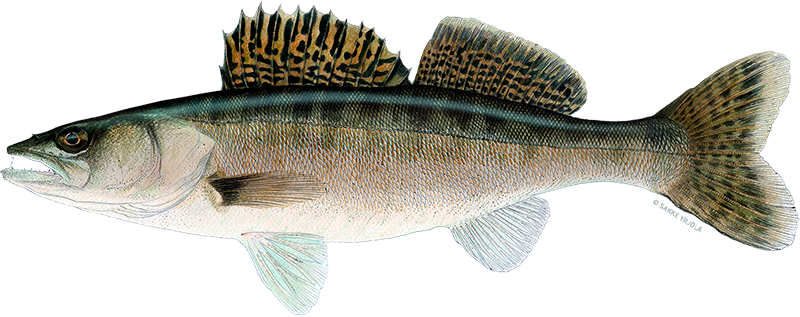
Sander lucioperca
Zander is commonly found in the lakes, rivers and the coastal waters of southern and mid Finland.
The northest zander populations of Finland and also for whole Europe are met in lake Miekojärvi in Pello region. Zander lives in large waters, where some rushes make the water dusty. If the water is clear the lake need to be deep to satisfy zander.
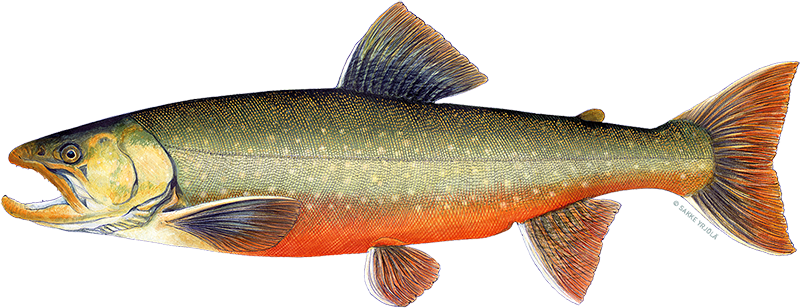
Salvelinus alpinus
Arctic char is the gem of northern waters. The char lives in cool and clear fresh water of rivers and lakes up in the fjell area. It is very picky when it comes to the living conditions and therefore you may need to take a little hike to find them. Kilpisjärvi is know to be home of some great chars and you may also find them from the northern parts of the Artery river system.
Arctic char is a local fish and doesn’t migrate much. Spawning time for char is autumn, when it searches for fairly shallow(1-3m) rocky ground to land the eggs. young chars eat insects from bottom but also from surface. As an adult it becomes a predator and starts to eat fish food and also its fellow chars. Best places to find char are small lakes/ponds and streams at the fjells. Ice fishing of char is a good reason to travel up north in the spring months, but also catching a char with dry fly under the midnight sun is something that every angler should experience.
Fish Art by Sakke Yrjölä www.sakkeyrjola.com